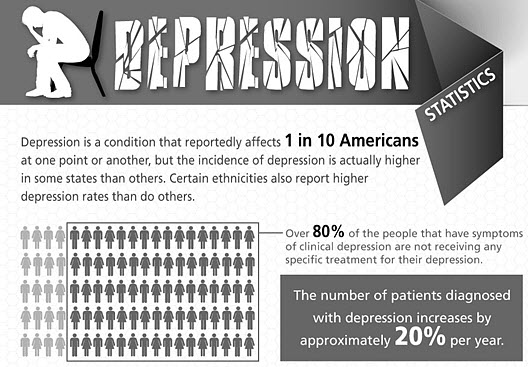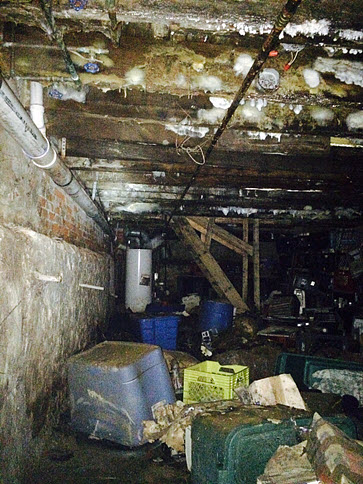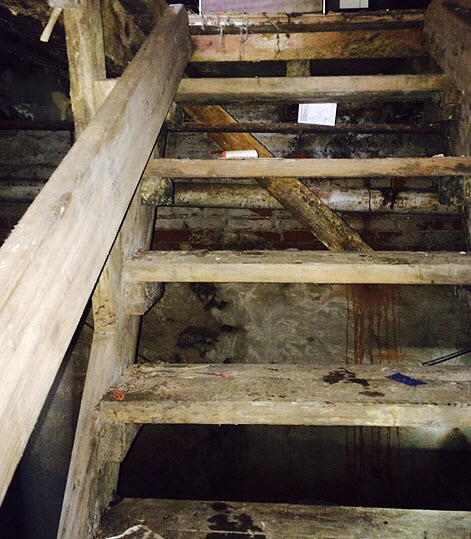[vc_row][vc_column width=”1/2″][vc_column_text]




[/vc_column_text][vc_column_text][/vc_column_text][/vc_column][vc_column width=”1/2″ css=”.vc_custom_1463158139681{border-radius: 5px !important;}”][vc_column_text]In previous posts we have discussed why a blog about property damage restoration would participate in Mental Health Awareness Month. It’s simple. We’re active in the communities we serve in Philadelphia and Southern New Jersey providing hoarding and biohazard cleanup services.
But this year, beyond our previous focus we’re helping get the word out about depression.
Did you know that:
1. Depression affects approximately 14.8 million American adults, or about 6.7 percent of the U.S. population age 18 and older, in a given year. (Archives of General Psychiatry, 2005 Jun; 62(6): 617-27)
2. Depression can develop at any age. (U.S. Census Bureau Population Estimates by Demographic Characteristics, 2005)
3. Depression is more prevalent in women than in men. (Journal of the American Medical Association, 2003; Jun 18; 289(23): 3095-105)
4. As many as one in 33 children and one in eight adolescents have clinical depression. (Center for Mental Health Services, U.S. Dept. of Health and Human Services, 1996)
5. People with depression are four times as likely to develop a heart attack than those without a history of the illness. (National Institute of Mental Health, 1998)
6. The number of people diagnosed with depression has increased significantly – by 20% every year
But did you also know that there is mounting evidence in scientific research linking exposure to mold and depression?
Most people associate wheezing, shortness of breath, stuffy nose, cough, headaches, skin, throat, lung infections and eye irritations with exposure to mold.
But the research is compelling: severe inflammatory response after exposure to molds can trigger depression in mold sensitized individuals.[/vc_column_text][/vc_column][/vc_row][vc_row][vc_column][vc_column_text]In the most recent study, published in JAMA Psychiatry, the researchers found that people with clinical depression had a 30 percent increase in brain inflammation, also referred to as neuroinflammation. It’s uncertain whether the inflammation caused the depression or vice versa, or if it’s simply a correlation. But the study makes it clear that the link should be further examined.
“This finding provides the most compelling evidence to date of brain inflammation during a major depressive episode,” Dr. Jeffrey Meyer of CAMH’s Campbell Family Mental Health Research Institute said in the press release. “Previous studies have looked at markers of inflammation in blood, but this is the first definitive evidence found in the brain. Depression is a complex illness and we know that it takes more than one biological change to tip someone into an episode,” Meyer said in the press release. “But we now believe that inflammation in the brain is one of these changes that’s an important step forward.”
The problem is, unless you know to look for it, probably most people don’t associate diverse physical and psychological symptoms of depression to mold exposure.
But, a serious mold problem — easily evidenced by either the smell of a musty odor or the sighting of slimy, furry and discolored patches on walls or ceilings — can develop and fester after excessive and continuous water damage.
Most often molds found in the home or in the workplace are caused by some type of water damage or brought in from the outside to grow and flourish.
Indoor flooding, leaking pipes or windows, and leaking roofs all are common causes of indoor mold.
Up to 40% of homes in the U.S. have experienced water damage at some point in their history.
The mold found in many homes across the country is microscopic fungi that grow on any host surface. Although mold prefers to grow and even thrives on certain surfaces like paper, cloth, wood, etc, it can grow just about anywhere if the conditions are right. This means mold could even grow on concrete or glass – if it’s dirty or covered with organic material that can feed the mold.
Molds are survivors and very adaptable, easily able to not just survive but thrive in many home environments.
And 25-28% of the general population are “mold sensitized individuals” – that is, they have a genetic predisposition to mold sensitivity.
The link between mold and depression starts with mycotoxins.
Mycotoxins are known to cause allergic and other adverse health reactions through an increased systemic inflammatory condition in animal species.
But here’s the thing: Despite the growing scientific evidence, the U.S. government has not established general guidelines for acceptable levels of residential or workplace mold. Even though the research evidence continues to mount, it has not recognized conclusively that exposure to mold is linked to mental or other health problems for 25% of the population with mold sensitivity.
If you suspect that you have a sensitivity to mold, or you have experienced depression that did not respond to standard treatment, be proactive! Get your home and workplace tested.
It may be the mold you can’t see that’s causing the problem!
References:
[1] Benros, ME, Waltoft B, Nordentoft M, Østergaard SD, Eaton W, Krogh, J, Mortensen PB. Autoimmune Diseases and Severe Infections as Risk Factors for Mood Disorders: A Nationwide Study. DrMedSc, JAMA Psychiatry. 2013;70(8):812-820. doi:10.1001/jamapsychiatry.2013.1111.
[2] Shenassa ED, Daskalakis C, Liebhaber A, Braubach M, Brown M. Dampness and mold in the home and depression: an examination of mold-related illness and perceived control of one’s home as possible depression pathways. Am J Public Health. 2007 Oct;97(10):1893-9. Epub 2007 Aug 29.
[3] Arnett SV, Clark IA. Inflammatory fatigue and sickness behavior: lessons for the diagnosis and management of chronic fatigue syndrome. J Affect Disord. 2012 Dec 10;141(2-3):130-42. doi: 10.1016/j.jad.2012.04.004. Epub 2012 May 11.
[4] Dowlati Y, Herrmann N, Swardfager W, et al. A meta analysis of cytokines in major depression including 24 studies reports significantly higher concentrations of the proinflammatory cytokines TN alpha and IL6 in depressed subjects compared with control subjects Also A meta analysis of cytokines in major depression. Biol Psychiatry 2010; 67: 44657.
[5] Miller AH, Maletic V, Raison CL. Inflammation and its discontents: the role of cytokines in the pathophysiology of major depression. Biol Psychiatry. 2009;65:732-741.
[6]Irwin MR, Levin MJ, Laudenslager ML, Olmstead R, Lucko A, Lang N, Carrillo C, Stanley HA, Caulfield MJ, Weinberg A, Chan IS, Clair J, Smith JG, Marchese RD, Williams HM, Beck DJ, McCook PT, Zhang JH, Johnson G, Oxman MN. Varicella Zoster Virus–Specific Immune Responses to a Herpes Zoster Vaccine in Elderly Recipients With Major Depression and the Impact of Antidepressant Medications. Clinical Infectious Diseases, 2013; DOI: 10.1093/cid/cis1208
[7] Lu S1, Peng H, Wang L, Vasish S, Zhang Y, Gao W, Wu W, Liao M, Wang M, Tang H, Li W, Li W, Li Z, Zhou J, Zhang Z, Li L. Elevated specific peripheral cytokines found in major depressive disorder patients with childhood trauma exposure: a cytokine antibody array analysis. Compr Psychiatry.2013 Oct;54(7):953-61. doi: 10.1016/j.comppsych.2013.03.026. Epub 2013 Apr 29.
[8] Lee M. Neurotransmitters and microglial-mediated neuroinflammation. Curr Protein Pept Sci.2013 Feb;14(1):21-32.
[9] Erhardt S, Lim CK, Linderholm KR, Janelidze S, Lindqvist D, Samuelsson M, Lundberg K, Postolache TT, Träskman-Bendz L,Guillemin GJ, Brundin L. Connecting inflammation with glutamate agonism in suicidality. Neuropsychopharmacology.2013 Apr;38(5):743-52. doi:10.1038/npp.2012.248. Epub 2012 Dec 3.
[10] Falcone T, Carlton E, Franco K, Janigro D. Inflammation, psychosis, and the brain. Psychiatr Times 2009; 26.
[11] Stertz L, Magalhães PV, Kapczinski F. Is bipolar disorder an inflammatory condition? The relevance of microglial activation. CurrOpin Psychiatry. 2013;26:19-26.
[12] Cascella NG, Kryszak D, Bhatti B, Gregory P, Kelly DL, Mc Evoy JP, Fasano A, Eaton WW. Prevalence of Celiac Disease and Gluten Sensitivity in the United States Clinical Antipsychotic Trials of Intervention Effectiveness Study Population. Schizophr Bull. Jan 2011; 37(1): 94–100. Published online Jun 3, 2009. doi: 10.1093/schbul/sbp055
[13] Crago BR, Gray MR, Nelson LA, Davis M, Arnold L, Thrasher JD. Psychological, neuropsychological, and electrocortical effects of mixed mold exposure. Arch Environ Health. 2003 Aug;58(8):452-63.
[14] Gordon WA, Cantor JB, Johanning E, Charatz HJ, Ashman TA, Breeze JL, Haddad L, Abramowitz S. Cognitive impairment associated with toxigenic fungal exposure: a replication and extension of previous findings. Appl Neuropsychol. 2004;11(2):65-74.
[15] Doi K, Uetsuka K. Mechanisms of Mycotoxin-Induced Neurotoxicity through Oxidative Stress-Associated Pathways. Int J Mol Sci. 2011;12(8):5213-37. doi: 10.3390/ijms12085213. Epub 2011 Aug 15.
[16] Jedrychowski W, Maugeri U, Perera F, Stigter L, Jankowski J, Butscher M, Mroz E, Flak E, Skarupa A, Sowa A. Cognitive function of 6-year old children exposed to mold-contaminated homes in early postnatal period. Prospective birth cohort study in Poland. Physiol Behav. 2011 Oct 24;104(5):989-95. doi: 10.1016/j.physbeh.2011.06.019. Epub 2011 Jul 8.
[17] http://www.survivingmold.com/diagnosis/neuroquant
[18] Eby, G. A., & Eby, K. L. (2006). Rapid recovery from major depression using magnesium treatment. Medical hypotheses, 67(2), 362-370.
[19] Braidy N, Grant R, Adams S, Guillemin GJ (January 2010). “Neuroprotective effects of naturally occurring polyphenols on quinolinic acid-induced excitotoxicity in human neurons”. FEBS J. 277 (2): 368–doi:10.1111/j.1742-4658.2009.07487.x. PMID 20015232.
[20] Benton, D. et al. (2007) Impact of consuming a milk drink containing a probiotic on mood and cognition. Eur. J. Clin. Nutr. 61, 355–361.
[21] Messaoudi, M. et al. (2011) Beneficial psychological effects of a probiotic formulation (Lactobacillus helveticus R0052 and Bifidobacterium longum R0175) in healthy human volunteers. Gut Microbes 2, 256–261.
[22] FredricksonBL, GrewenKM, Coffey KA, Algoe SB, Firestine AM, Arevalo JMG, Ma J, Cole SW. A functional genomic perspective on human well-being. Proceedings of the National Academy of Science, Aug. 13, 2013;110(33):13684-9. doi:10.1073/pnas.1305419110. Epub 2013 Jul 29.
[23] Setiawan E, Wilson A, Mizrahi R, Rusjan P, Miler L, Rajkowska G. “Role of Translocator Protein Density, a Marker of Neuroinflammation, in the Brain During Major Depressive Episodes.” JAMA Psychiatry, 2015.
[24] Wilson et al. Cytokines and cognition – The case for a head to toe inflammatory paradigm. JAGS 50:2041–2056, 2002.
[25] Nayak AP, Green BJ, Lemons AR, Marshall NB, Goldsmith WT, Kashon ML, Anderson SE, Germolec DR, Beezhold DH 2016. Subchronic exposures to fungal bioaerosols promotes [sic] allergic pulmonary inflammation in naive mice. Clin Exp Allergy; doi:10.1111/cea.12724. [Online 19 Feb 2016]
[26] Brewer JH, Thrasher JD, Straus DC, Madison RA, Hooper D Detection of Mycotoxins in Patients with Chronic Fatigue Syndrome Toxins 2013, 5(4), 605-617[/vc_column_text][/vc_column][/vc_row][vc_row][vc_column][vc_column_text]
If you have experienced depression that has not been helped by standard treatment, it’s time to get your work and home environments tested for mold!
PuroClean Emergency Recovery Services does mold remediation and removal, not mold testing. If you need a referral to a mold testing company give us a call at 877-750-7876
[/vc_column_text][/vc_column][/vc_row]
